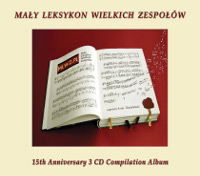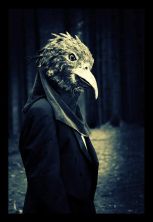 Danish-born photographer, filmmaker and visual artist Lasse Hoile is best known for his more-than-decade-long collaboration with Porcupine Tree’s mastermind, British composer and musician Steven Wilson. Hoile has created a huge output of album artwork, associated photography and live visuals for nearly every album Wilson has put out since 2002, garnering wide acclaim and a sort of a cult following for himself too in the process, with some people actually discovering the music via his memorable works. Yet, through all these years he has remained something of a mystery figure, hardly ever revealing his face to the public. This interview is surely going to shed some light on the man, reveal why he is so keen on the bleak and the gloomy, where his inspirations come from and how his native Denmark tends to influence a creative mind.
Danish-born photographer, filmmaker and visual artist Lasse Hoile is best known for his more-than-decade-long collaboration with Porcupine Tree’s mastermind, British composer and musician Steven Wilson. Hoile has created a huge output of album artwork, associated photography and live visuals for nearly every album Wilson has put out since 2002, garnering wide acclaim and a sort of a cult following for himself too in the process, with some people actually discovering the music via his memorable works. Yet, through all these years he has remained something of a mystery figure, hardly ever revealing his face to the public. This interview is surely going to shed some light on the man, reveal why he is so keen on the bleak and the gloomy, where his inspirations come from and how his native Denmark tends to influence a creative mind.
Dima Oliferowicz: Hi Lasse! You quickly rose to fame in the world of progressive music in the early 2000s when you created a whole new visual concept for Porcupine Tree’s then new release ‘In Absentia’. You’ve since collaborated with numerous musical artists creating album covers that jell so well with the music. Did you get involved because you were a music fan yourself or just the area seemed creatively promising and you tapped into it on a whim?
Lasse Hoile: Well, I’m not sure about the “fame” part! I certainly don’t feel “famous” if there is a bar for such a thing, if there is it’s most surely not to reach me (or my head). I surely don’t work with that many really, if I could I would love to work with a lot more but I guess it all comes down to what people like and I just feel, and have been, lucky to work with Porcupine Tree and perhaps got in touch with them before they became known I guess. What makes me happy though is when you mention that my work “jell” with the music which is all I’m really trying, and if that makes other people feel the same way it means I’m doing something right which is only what I can try and do.
But art has always been something I needed to do one way or the other since I can remember and love for music has also been there very early and exploring so I guess you can say it kinda just melted together in a strange way. I can’t play any instrument and I’m terrible bad at counting and I couldn’t get into art school way back and been horrible at painting so I took up photography, perhaps out of making short films and love for films too back in the day and that’s where it just started I guess you can say.
I think you kinda just have to do what you do and you gravitate towards, what it is your find is your call so to speak when you find it (or if you do). You don’t really choose to do it, it kinda chooses you in a strange way… if that makes any sense?
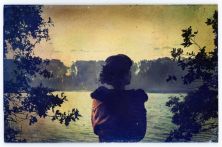 DO: Tell us about how you started. You are from the town of Aarhus in Denmark. What kind of place is it to grow up in? How did you develop a passion for photography in the first place?
DO: Tell us about how you started. You are from the town of Aarhus in Denmark. What kind of place is it to grow up in? How did you develop a passion for photography in the first place?
LH: I think most of this is also in the above :-) But yes, from the town of Aarhus in DK, although my Dad is British and have also been living over there for a while + a few years in Greenland and what not.
It’s a small cozy town in many ways, always tried to leave, but haven’t gotten away yet, it’s my little base kinda. The town is small, but so is the country in many ways, you can interpret that as you want.
DO: Who or what do you consider your creative influences? I’ve read, for example, that Tarkovsky’s films were a major influence on you.
LH: You always start out with someone or something you say or heard that really made an impact on you of course and in some ways they stay with you but gradually you find your own voice along the way, you must! So a lot things I guess have planted small seeds growing up and trying to find out what you want to do in life, music and art, again, has always been there but life happens and that always the biggest influence . But I always love looking back and discovering old stuff, the past in many ways… especially the Victorian period I love and all that was going on at that time too I love…. but there are many things, it can be anything from really small stupid banal things to heavy existential shit you know ? Everything interesting :-).
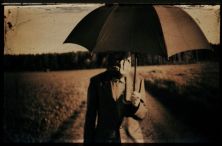 DO: Your photography and music videos are nearly always immersed in a dark, brooding, purgatory-like atmosphere, with dark laden skies and dark figures, weird bird-like critters and solemn woods. The visual set for Steven Wilson’s ‘Grace for Drowning’ album is a very telltale example of this. Are you trying to vent out some darker side of your personality via this medium, or does it happen, because a musician (say, Steven Wilson) comes round and says ‘Hey, I’ve got this sinister piece of music on demo’ and you only have to follow the nature of the music in question?
DO: Your photography and music videos are nearly always immersed in a dark, brooding, purgatory-like atmosphere, with dark laden skies and dark figures, weird bird-like critters and solemn woods. The visual set for Steven Wilson’s ‘Grace for Drowning’ album is a very telltale example of this. Are you trying to vent out some darker side of your personality via this medium, or does it happen, because a musician (say, Steven Wilson) comes round and says ‘Hey, I’ve got this sinister piece of music on demo’ and you only have to follow the nature of the music in question?
LH: Yes I get that a lot, although I’m sort of happy easy going really, well, at least I think I am most of the time; but perhaps being who I am a bit sensitive too, people and things around you also plays a role I think, I care a lot about the people I like and the world I live in, and when you see bad things happen, whatever that may be, it rubs on in some way, and perhaps that plays a role also. But I do think the most interesting aspects in art are from things that are just more dramatic in tone.
None of us want to be sad or unhappy or see bad shit, but we all like to watch movies that are sad or violent, same with books, theatre, sad music etc. For some reason we find that entertaining, I do but I wouldn’t want to be unhappy at all…perhaps it’s the escapism aspect too.
In the case with Grace it was our general love for old ghost stories and again just life in general that played a role for making Grace the way we did that. And old European art house films.
DO: Now, could you talk our readers through the nuts and bolts of album artwork making, basically, from the moment you are commissioned to do the job until you apply the final touch?
LH: It’s really different from album and who I work with, sometimes I already have an image they really like and sometimes you make hundreds of images and hope there is a cover somewhere… it’s a back and forth process also which I like because you maybe end up somewhere completely different from when you started and something new get’s created during that process.
For example, SW had a very clear idea what he wanted for Insurgentes and Grace… and now with the new release Hand. Cannot. Erase. I ended up taking literally around 4000 pictures, ditching a lot of course, trying out stuff, using, again, a lot of different formats, even paint this time, and I think I delivered about 1500 final images and we had a lot to choose from… so it’s not always easy, it never is really (otherwise it would be terrible boring also). So it’s really different… With In Absentia I already had that image made and Steve really liked it, just seemed to fit. Luckily with PT and SW - he’s always very visual too, so we work together and work it out, and with others it’s very hard, because, I think, they really don’t know what they want…
 DO: The general tendency in the music business over the last decade or so, since the download culture emerged, has been a steady decline of the physical format. The listener has mostly shifted to downloaded tracks and casts only a passing glance at the visual part of the package. Do you view this as a tragedy or a sort of purification of art: Those who do care will always buy an LP or CD and pour over the glossy little pages, so it is for them that you make the effort.
DO: The general tendency in the music business over the last decade or so, since the download culture emerged, has been a steady decline of the physical format. The listener has mostly shifted to downloaded tracks and casts only a passing glance at the visual part of the package. Do you view this as a tragedy or a sort of purification of art: Those who do care will always buy an LP or CD and pour over the glossy little pages, so it is for them that you make the effort.
LH: Of course it’s sad that the visual aspect really gets lost with the whole download scene, not only that but also just the general quality of the music too that people seem to like ! But in some ways it’s unavoidable and in other ways it’s really the industry fault too, and with that I mean that there really is a lot of horrible crap out there and it’s even more terrifying for me at least to see what people see as good shit and not, but it’s a hard one because we all love different things and can’t expect everyone to like this or that so I think we have to try even harder than ever to make an effort not to make mindless crap or pointless stuff as I sadly see done time and time again…
Luckily, I work with people who still want to make the effort and spend the money on creating something more than just the normal thing or a CD with a few pages of nothing.
But I do think people still want to buy a psychical thing when they can see what they get is high quality stuff and thought through proper.
When you spend so much time on a project and the musicians on the music you really don’t want to waste your own time on something you don’t believe in, and I think that thought goes with everything quality, it’s not really for being fancy or smart, but because there is meaning behind it.
DO: Although you’re a household name for any serious Porcupine Tree/Blackfield/Steven Wilson fanatic, you’ve been in great demand by other musicians and bands lately. Tell us please about your involvement with them. Is your working relationship/approach with them any different from that with Steven Wilson? Have you worked out any new creative techniques specifically for non-Wilson projects?
LH: Not sure I’m in great demand, I still struggle to pay the bills, I still end up having to sell my gear and things to make it at least once or twice a year, really don’t know how many computers, cameras, TV sets, even furniture I had to sell over the years to keep living in my flat, so it’s not for the cash I’m doing all this, ha-ha… Perhaps someday someone will actually pay proper for what I do!
But again, it’s very different from work to work which also makes it exciting to keep on going, no work is the same and it keeps you on your toes, which is also a good thing.
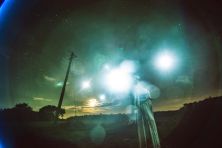 DO: Returning to the topic of SW and all it entails. As far as I know, you’ve never designed artwork for what is the longest-running and for some the most revered of his bands: No-Man. Why is it so?
DO: Returning to the topic of SW and all it entails. As far as I know, you’ve never designed artwork for what is the longest-running and for some the most revered of his bands: No-Man. Why is it so?
LH: You have to ask SW and Tim about that. But Carl Glover, who is a now a good friend of mine, is also a fantastic photographer, much better than me also technically, I think his images fit No-Man really well as his work with Bass Communion etc. Really beautiful stuff he does.
DO: Changing the subject from still imagery to moving pictures, I’m curious to learn about the principles of creating backdrop projections for concerts. What is their primary purpose? Are they meant to provide a clear and simple explanation, a visualization of the music being played? But then, they are a distraction from what’s going on on stage, from watching how the music is being played? Do you strive to arrive at some sort of compromise to create a balance?
LH: It’s a balance of course, but it’s also a show, you really have to make the concert experience and experience today, also since less people are buying the physical product! I guess it’s about enhancing the songs in some ways, and you want to make the music more visual too, but a lot of these visuals are not from start to finish they are here and there throughout the show, small films with some plot, some are just an extension of the light show… again, it depends on what mood you want to try and convey! A lot of shows just have all this random stuff going on from that to finish, and some again, perhaps not thought through properly, and lots just seem to have visuals, because everyone else are doing it, but I think the balance of everything is very important, of course, or you just get too overwhelmed that it defeats its purpose.
DO: Let’s talk about the movie ‘Insurgentes’ directed by you in 2008, which is one of those motion pictures that defy clear boundaries and can’t be tagged precisely genre-wise. It’s a documentary about an independent musician, but it almost feels like a noir feature film too. It’s a globe-trotting film of seemingly haphazard locations and snaps of Steven talking, yet it’s meant to deliver to the audience one particular kind of message – an independent musician in disagreement with the globalised world of iPods and download culture.
LH: Yes! And that’s really it :-) Well, it started as a simple “making of” album thing, but it turned out a little bigger in the end, but I wanted to have more people getting to know SW really, and I was in agreement with everything he said about the download culture and generally what he was saying in interviews and thoughts and stuff we had been talking about; I thought it would make for an interesting sort of film + we liked fucked up shit too, so we tried to be ambitious as we could with very little money and resources, we tried getting grants and what not, so we could interview more people in the industry and what not, but, sadly, we didn’t get much help, but I think we made a great little piece of time then.
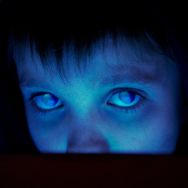 DO: Can you please explain the most often recurring elements in your photographs, such as long rolls of white cloth on the ground, individuals with blurred/erased faces, with antlers or fingers resembling sprawling tree roots, disquieting old home interiors etc. Did you come up with this exotic imagery spontaneously or are the viewers supposed to try and decode their hidden messages?
DO: Can you please explain the most often recurring elements in your photographs, such as long rolls of white cloth on the ground, individuals with blurred/erased faces, with antlers or fingers resembling sprawling tree roots, disquieting old home interiors etc. Did you come up with this exotic imagery spontaneously or are the viewers supposed to try and decode their hidden messages?
LH: I’m not sure they are recurring! They are just ideas I got, probably from seeds planted a long time ago, and made them when I could, as like many others I have a little notebook with ideas all the way back from when I started, but there are a lot I still haven’t made yet simply because I need budget’s to make it happen, it’s really simple as that ! What I’m doing now is very far from what I did say two years ago, been playing a lot with light and paint, and what not, and a lot of that is in the new SW album too, so hopefully soon I can release all these new images that have been building up for about a year now!
DO: Could you give us an insight into your future plans? Do you have any plans to carry on with the bands you have collaborated with? Are you working on any new stuff at the moment?
LH: I do hope I can continue to work with the folks I’ve been collaborating with of course, and hopefully I can add some new ones too but it’s not up to me, I try to reach out and try new stuff but it’s hard these days, again, a lot of bands seem to be content with iphone pictures and free stuff too, which is, of course, nothing wrong with that, but it gets harder to make a living doing only this, because it’s also a costly affair too or can be depending on what’s being done… I just hope I can keep on doing what I love and that’s all I can hope for.

